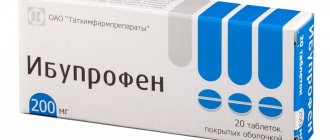Description of the drug IBUPROFEN
With simultaneous use, ibuprofen reduces the effect of antihypertensive drugs (ACE inhibitors, beta-blockers), diuretics (furosemide, hydrochlorothiazide).
When used simultaneously with anticoagulants, their effect may be enhanced.
When used simultaneously with GCS, the risk of side effects from the gastrointestinal tract increases.
When used simultaneously, ibuprofen can displace indirect anticoagulants (acenocoumarol), hydantoin derivatives (phenytoin), and oral hypoglycemic drugs, sulfonylurea derivatives, from compounds with blood plasma proteins.
When used simultaneously with amlodipine, a slight decrease in the antihypertensive effect of amlodipine is possible; with acetylsalicylic acid - the concentration of ibuprofen in the blood plasma decreases; with baclofen - a case of increased toxic effects of baclofen has been described.
When used simultaneously with warfarin, an increase in bleeding time is possible; microhematuria and hematomas were also observed; with captopril - the antihypertensive effect of captopril may be reduced; with cholestyramine - a moderate decrease in the absorption of ibuprofen.
When used simultaneously with lithium carbonate, the concentration of lithium in the blood plasma increases.
When used simultaneously with magnesium hydroxide, the initial absorption of ibuprofen increases; with methotrexate - the toxicity of methotrexate increases.
The simultaneous use of NSAIDs and cardiac glycosides can lead to worsening heart failure, a decrease in glomerular filtration rate and an increase in the concentration of cardiac glycosides in the blood plasma.
There is evidence of the likelihood of an increase in the concentration of methotrexate in the blood plasma during the use of NSAIDs.
With simultaneous use of NSAIDs and cyclosporine, the risk of nephrotoxicity increases.
NSAIDs may reduce the effectiveness of mifepristone, so taking NSAIDs should be started no earlier than 8-12 days after stopping mifepristone.
Concomitant use of NSAIDs and tacrolimus may increase the risk of nephrotoxicity.
Concomitant use of NSAIDs and zidovudine may lead to increased hematotoxicity. There is evidence of an increased risk of hemarthrosis and hematomas in HIV-positive patients with hemophilia who received concomitant treatment with zidovudine and ibuprofen.
In patients receiving concomitant treatment with NSAIDs and quinolone antibiotics, the risk of seizures may increase.
In patients receiving concomitant NSAIDs and myelotoxic drugs, hematotoxicity increases.
With the simultaneous use of ibuprofen and cefamandole, cefoperazone, cefotetan, valproic acid, plicamycin, the incidence of hypoprothrombinemia increases.
With the simultaneous use of ibuprofen and drugs that block tubular secretion, there is a decrease in excretion and an increase in plasma concentration of ibuprofen.
With the simultaneous use of ibuprofen and inducers of microsomal oxidation (phenytoin, ethanol, barbiturates, rifampicin, phenylbutazone, tricyclic antidepressants), there is an increase in the production of hydroxylated active metabolites and an increased risk of developing severe intoxications.
Ibuprofen ointment 50 mg/g 15 g No. 1
Name
Ibuprofen ointment for external use, 50 mg/g in 15 g tubes.
Main active ingredient
Ibuprofen.
Release form
Ointment.
Dosage
50mg/g.
pharmachologic effect
The drug belongs to non-steroidal anti-inflammatory drugs for topical use. Ibuprofen has anti-inflammatory and analgesic effects. Relieves pain, incl. arthralgia at rest and during movement; reduces morning stiffness and swelling of joints, helps increase range of motion.
Indications for use
muscle pain; degenerative joint diseases (osteoarthritis); inflammatory rheumatic diseases of the joints and spine; swelling and inflammation of the periarticular soft tissues (articular capsule, tendon, ligaments, joint capsule, tendon sheath); glenohumeral periarthritis (frozen shoulder syndrome), low back pain, lumbago; injuries without compromising the integrity of soft tissues (bruise, sprained ligaments, tendons). Ibuprofen ointment is indicated for the treatment of adults and children over 14 years of age.
Directions for use and doses
Externally. A strip of the drug 5-10 cm long is applied to the affected area and thoroughly rubbed in with light movements until completely absorbed 3-4 times a day for 2-3 weeks.
Precautionary measures
The drug is intended for external use only. Avoid contact of the drug with mucous membranes or eyes. Application in pediatrics. Ibuprofen ointment should not be used to treat children under 14 years of age due to the lack of sufficient data on safety and effectiveness. Patients with asthma, hay fever, chronic lung disease, chronic respiratory tract infections and those with hypersensitivity to analgesics and anti-rheumatic drugs are at greater risk of developing asthmatic attacks, mucosal edema or urticaria than other patients. The use of the drug in these patients must be carried out under the supervision of a physician. The drug should be used with caution in patients with hypersensitivity (allergy) to other substances, manifested by skin irritation, itching, and urticaria. If symptoms persist for more than 3 days, you should consult your doctor.
Interaction with other drugs
There are no cases of negative drug interactions when prescribing this drug with other drugs included in generally accepted treatment regimens. Caffeine enhances the analgesic effect of ibuprofen.
Contraindications
Hypersensitivity, incl. to other non-steroidal anti-inflammatory drugs, weeping dermatoses, eczema, violations of the integrity of the skin (including infected abrasions and wounds), age under 14 years, pregnancy, lactation.
Compound
1 g of ointment contains: active substance: ibuprofen - 50 mg; dimethyl sulfoxide - 100 mg; excipients: macrogol - 400, macrogol - 1500.
Overdose
Cases of overdose with the use of the drug have not been described. With long-term use, systemic side effects of non-steroidal anti-inflammatory drugs may develop.
Side effect
As a rule, no adverse effects are observed when using the drug. Possible skin hyperemia, burning or tingling sensation. In rare cases, allergic reactions (skin rash, itching, Quincke's edema) are possible. If allergic reactions occur, treatment with the drug should be stopped and, if necessary, desensitizing therapy should be carried out. If the above adverse reactions or adverse reactions not listed in these instructions for medical use of the drug occur, you should consult a doctor.
Storage conditions
At a temperature not higher than 25°C. Keep out of the reach of children.
Buy Ibuprofen ointment d/nar.approx. 50 mg/g in tubes 15 g in pack No. 1 in the pharmacy
Price for Ibuprofen ointment d/nar. approx. 50 mg/g in tubes 15 g in pack No. 1
Instructions for use for Ibuprofen ointment d/nar. approx. 50 mg/g in tubes 15 g in pack No. 1
Ibufen gel for 10% 50g No. 1
Name
Ibufen gel.
Release forms
Gel.
INN
Ibuprofen.
FTG
Npvp.
Compound
1 g of gel contains: active ingredient: ibuprofen lysine salt 100 mg excipients: polyethylene glycol 200, methyl parahydroxybenzoate (E 218), propyl parahydroxybenzoate (E 216), carbomer 980, bitter orange oil, triethanolamine, purified water.
Description
Light yellow or yellow, slightly opalescent gel with a characteristic odor.
Pharmacotherapeutic group
Nonsteroidal anti-inflammatory drugs for external use ATC code: M02AA13
Pharmacological properties
Ibufen® gel has a pronounced analgesic and anti-inflammatory effect due to the suppression of prostaglandin synthesis. Suppresses the production of inflammatory mediators. Inhibits cyclooxygenase and blocks prostaglandin biosynthesis. The anti-inflammatory effect is due to the normalization of increased vascular permeability, improvement of microcirculation, reduction of the liberation of histamine, bradykinin and other inflammatory mediators, inhibition of ATP formation, which causes a decrease in the energy supply of the inflammatory process. The analgesic effect of ibuprofen is associated with a decrease in the intensity of inflammation, a decrease in the production and weakening of the algogenicity of bradykinin. Ibufen® gel contains ibuprofen in the form of a hydrotropic compound with lysine - ibuprofen lysinate. The hydrotropic properties of ibuprofen lysinate provide faster release of ibuprofen in larger quantities than when using ibuprofen in the form of free acid. Lysine, which is part of this active ingredient, accelerates the penetration of ibuprofen into the deep layers of the skin without increasing the degree of total absorption, by increasing its solubility in the hydrophilic gel. The effect occurs after 30 minutes and lasts for several hours. In articular tissues, therapeutic reliable concentrations of the drug are retained for several hours, while in the blood serum the active substance is contained only in small quantities. The biological transformation of ibuprofen occurs in the liver, and its release in the kidneys.
Indications for use
Ibufen® gel is used for local primary and auxiliary treatment for: - muscle pain; — degenerative joint diseases (osteoarthrosis); - inflammatory rheumatic diseases of the joints and spine; - swelling and inflammation of the periarticular soft tissues (articular capsule, tendon, ligaments, joint capsule, tendon sheath); - humeroscapular periarthritis (frozen shoulder syndrome), lower back pain, lumbago; - injuries (including sports) without violating the integrity of soft tissues (bruise, sprained ligaments, tendons).
Contraindications
Ibufen® should not be used in cases of: - individual hypersensitivity to ibuprofen or any of the excipients, acetylsalicylic acid and other non-steroidal anti-inflammatory drugs, - allergic skin diseases, - infectious diseases with changes in the skin, - burns, - integrity disorders skin - history of bronchospasm, rhinitis and urticaria associated with taking acetylsalicylic acid or other NSAIDs. There are no sufficient indications for the use of the drug Ibufen® gel in children under 12 years of age, therefore it is not recommended to use the drug in children under 12 years of age without a doctor’s prescription.
Interaction with other drugs
Drug interactions with ibuprofen when used externally have not been described, but interactions such as when taken orally cannot be completely excluded. However, it should be borne in mind that even when applied topically, ibuprofen has a systemic effect, and, theoretically, the simultaneous use of the gel with other NSAIDs may increase side effects.
special instructions
When using ibuprofen, caution should be exercised in patients with impaired liver or kidney function, as well as with gastric and/or duodenal ulcers. Patients with bronchial asthma who have not previously taken acetylsalicylic acid or other NSAIDs are recommended to consult a doctor before using the medicinal product Ibufen® gel. Ibuprofen applied topically may cause gastrointestinal side effects. Although the risk of such side effects is significantly less than when taking ibuprofen orally, patients with gastrointestinal disorders should consult a doctor before using Ibufen® gel. Avoid getting the gel into the eyes and mucous membranes. In case of skin changes in the area of application, the use of the drug should be discontinued. If prolonged application to the skin is necessary, it is recommended to use protective gloves. The interval between uses of the drug should be at least 4 hours. After using the gel, wash your hands thoroughly, unless your hands are a sore spot. If 2 weeks after using the drug the symptoms do not stop or worsen, you should consult a doctor. The concentration of ibuprofen in the circulatory system when used externally is less than when taken orally. However, due to the fact that ibuprofen taken orally can worsen existing renal failure, patients with a history of kidney disease should consult a doctor before using Ibufen® gel.
Pregnancy and lactation
Do not use during pregnancy or breastfeeding. Pregnancy: Although no teratogenic effect has been found, ibuprofen should be avoided during pregnancy. There may be a delay in the onset of labor and an extension of the delivery period. Lactation: Ibuprofen can pass into breast milk in very low concentrations, but its effect on a breastfed baby is unlikely.
Impact on the ability to drive motor vehicles and maintain mechanical equipment
There is no information on contraindications to driving and servicing machinery after taking Ibufen® gel.
Directions for use and doses
For external use. Adults and children over 12 years of age: A strip of gel about 3 cm long is applied to the affected area and rubbed thoroughly with light movements until completely absorbed 3 times a day. Do not exceed the recommended dose.
Overdose
Overdose after external use is unlikely. If the drug gets into the oral cavity, symptoms of overdose may occur. The half-life of the drug after an overdose ranges from 1.5 to 3 hours. Symptoms of overdose when taking the drug orally Most patients taking NSAIDs experienced: nausea, vomiting, pain in the epigastric region, and less commonly, diarrhea. Tinnitus, headache, and gastrointestinal bleeding were also noted. In more severe cases, disturbances from the peripheral nervous system were noted in the form of drowsiness, temporary agitation, disorientation or coma. Convulsions were also observed periodically, and in severe poisoning, metabolic acidosis and prolongation of prothrombin time (PT/INR) were also observed. Acute renal failure and liver disorders were also observed. The possibility of increased asthma symptoms in asthmatics was also noted. Measures in case of overdose If the drug was accidentally taken orally, it is necessary to induce vomiting, gastric lavage (within an hour after administration), take activated charcoal, and alkaline drink. Symptomatic and supportive therapy is used.
Side effects
General disorders at the site of application: - skin disorders (for example, redness) and a crawling sensation at the site of application of the drug, - nonspecific allergic and anaphylactic reactions. Respiratory, thoracic and mediastinal disorders: - asthma, exacerbation of asthma, bronchospasm or shortness of breath. Disorders of the skin and subcutaneous tissues: - rashes of various types, - itching, - urticaria, - Quincke's edema, - toxic epidermal necrolysis and erythema multiforme (rare). Gastrointestinal disorders: - abdominal pain, - dyspepsia. With prolonged use over a large surface of the body, additional side effects may develop, such as: headache, dizziness, changes in the blood picture (granulocytopenia, agranulocytosis), hyperuricemia, and from the gastrointestinal tract - nausea, vomiting, loss of appetite, relapse of gastric ulcer and duodenum. During treatment with ibuprofen, kidney problems are also possible, particularly in patients with kidney disease. Any side (unusual) effects, including those not listed in the package insert, should be reported to your doctor.
Best before date
2 years. An opened tube must be used within 6 months.
Vacation conditions
Over the counter.
Storage conditions
Store in a place protected from light at a temperature of 15°C to 25°C. The medicine should be stored out of the reach of children.
Package
50 g in aluminum tubes. 1 tube together with a leaflet is placed in individual cardboard packs.
Buy Ibufen gel d/nar.prim. 10% in tubes 50g per pack. No. 1 in pharmacy
Price for Ibufen gel d/nar.approx. 10% in tubes 50g per pack. No. 1
Instructions for use for Ibufen gel d/nar.prim. 10% in tubes 50g per pack. No. 1


